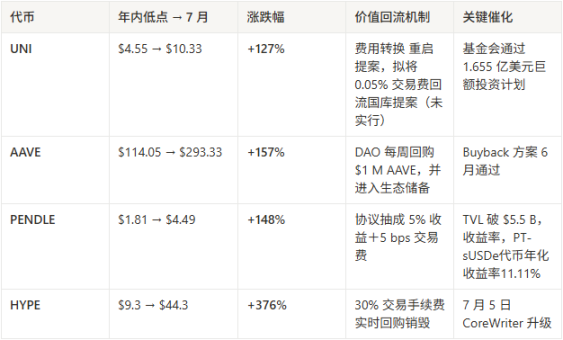Countless altcoins are on a downward trend, continuously hitting new lows, while some utility tokens are attracting funds to flow upstream, with prices and on-chain revenues both rising.
Written by: Yi Nan
In early 2025, as liquidity in the secondary market tightened, a large number of altcoins driven by "story + airdrop" were ruthlessly deflated.
Countless altcoins are on a downward trend, continuously hitting new lows—during the same period, Bitcoin's market cap share rose to 62.1%, a five-year high, while the Altcoin Season Index even hit a record low of 4 points in May 2023.
However, utility tokens like Uniswap (UNI), Aave (AAVE), Pendle (PENDLE), and Hyperliquid (HYPE) are attracting funds to flow upstream, with prices and on-chain revenues both rising.
They share a common characteristic: real, auditable protocol cash flow, which returns value to token holders through buybacks, profit sharing, or staking.
This article attempts to outline the logic of capital migration after the VC bubble burst and uses four representative projects as samples to explore how the "on-chain P/E era" is reshaping the crypto valuation system.
Market Background: When Narratives Retreat, Cash Flow Becomes Scarce
VC Slowdown: In Q2 2025, global crypto financing dropped sharply to $4.99 billion, a 21% quarter-on-quarter decline, marking a new low for a single quarter since 2020, as investors became cautious about "concept hype."
Funds Flow Back to Blue-Chip DeFi: Bitcoin continues to strengthen and dominate, but there is significant differentiation within the DeFi sector; protocols with a "revenue-distribution" closed loop see their TVL and trading volume continue to rise. Pendle's TVL surpassed $5.59 billion in July, nearly tripling within the year.
Valuation Anchor Shift: In a traditional risk-off cycle, investors are more willing to pay for quantifiable cash flow rather than pure narrative premiums.
What are "Utility Tokens"?
Definition: Token holders can share protocol revenue (Fee Capture) or indirectly enhance each token's "on-chain EPS" (verifiable earnings per token) through buybacks/burns or staking profit sharing.
Typical Models
Fee Switch / Trading Profit Sharing: Proportionally return or buy back protocol fees (GMX).
Lending Interest Spread & Liquidation Fees: Include interest spreads and liquidation rewards in the treasury for buybacks (AAVE, Maker).
Yield Tokenization: Split future earnings for trading, with the protocol taking a cut (Pendle).
Infrastructure Fuel: High-frequency matching engine fees are immediately bought back and burned (HYPE).
Four Major Case Studies Overview

Analysis: How Cash Flow Drives Valuation Recovery?
Uniswap (UNI)
Previously, the market viewed UNI as a "pure governance token." Subsequently, the Uniswap Foundation voted to approve a massive investment plan of $165.5 million.
The Uniswap Foundation proposed allocating $165.5 million to the following areas:
$95.4 million for funding (developer programs, core contributors, validators);
$25.1 million for operations (team expansion, governance tool development);
$45 million for liquidity incentives.
Currently, the $UNI token has no actual token value capture or buyback plan!
Aave (AAVE)
Aave DAO approved a weekly buyback of approximately $1 million AAVE from protocol surplus, locking it into the DAO treasury:
The first week of execution pushed the daily increase by 13%, with trading volume doubling.
Lending interest spread + liquidation fees provide stable cash flow, and with V3 TVL growing 32% year-on-year, the buyback plan has long-term ammunition.
Pendle (PENDLE)
Pendle has turned the narrative of "future earnings" into a trading market:
Extracting 5% revenue + 5 bps trading fee generates auditable income for the protocol daily.
High-yield strategies (e.g., stETH YT yield once >11%) are more attractive in a low-interest environment, leading to continuous capital inflow.
Hyperliquid (HYPE)
As a high-frequency matching DEX, Hyperliquid launched CoreWriter precompiled in July, allowing HyperEVM contracts to place orders, settle, and call CLOB directly, with an on-chain fee buyback and burn mechanism:
In the week of the upgrade, both on-chain active addresses and trading volume hit all-time highs.
The immediacy of value return + the scale of high-frequency trading fees make HYPE a strong β in the "on-chain cash flow" narrative.
Three Moats to Survive the Bear Market
Certainty of Cash Flow: On-chain income & expenses are auditable, and DAO resolutions are publicly transparent, reducing information asymmetry.
Buyback / Profit Sharing Closed Loop: Writing the "protocol revenue → token value" path into smart contracts creates effects equivalent to stock buybacks or dividends.
Institution-Friendly: Quantifiable yield metrics (P/S, P/E) reduce valuation uncertainty, facilitating market making and structured product design.
Conclusion
After the retreat of VC narratives, the market is re-pricing "verifiable cash flow."
Utility tokens integrate on-chain income, token value, and governance rights, making them a scarce asset that can weather cycles.
As mainstream DeFi protocols gradually introduce Fee Switch (fee conversion), buybacks, or surplus distribution, it marks a shift in crypto market valuation logic from "narrative markets" to "cash flow markets."
免责声明:本文章仅代表作者个人观点,不代表本平台的立场和观点。本文章仅供信息分享,不构成对任何人的任何投资建议。用户与作者之间的任何争议,与本平台无关。如网页中刊载的文章或图片涉及侵权,请提供相关的权利证明和身份证明发送邮件到support@aicoin.com,本平台相关工作人员将会进行核查。




